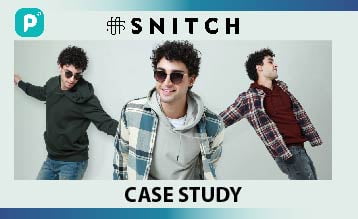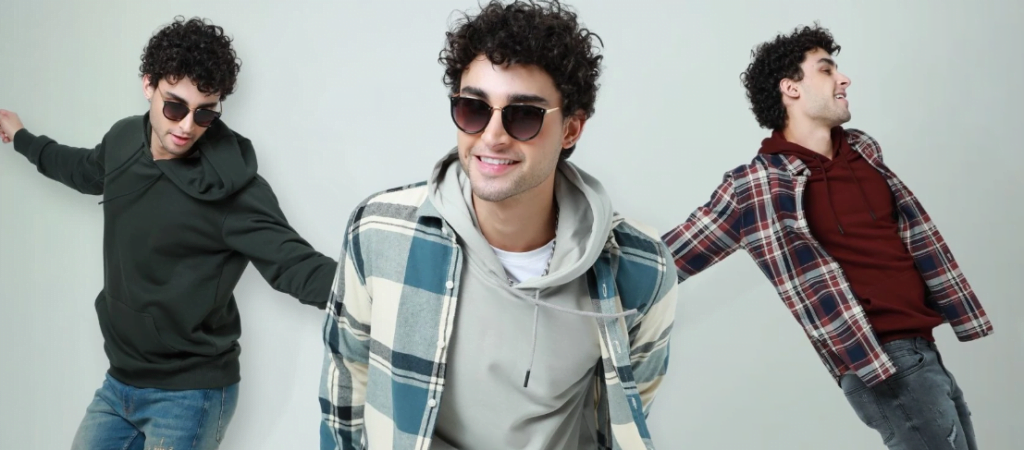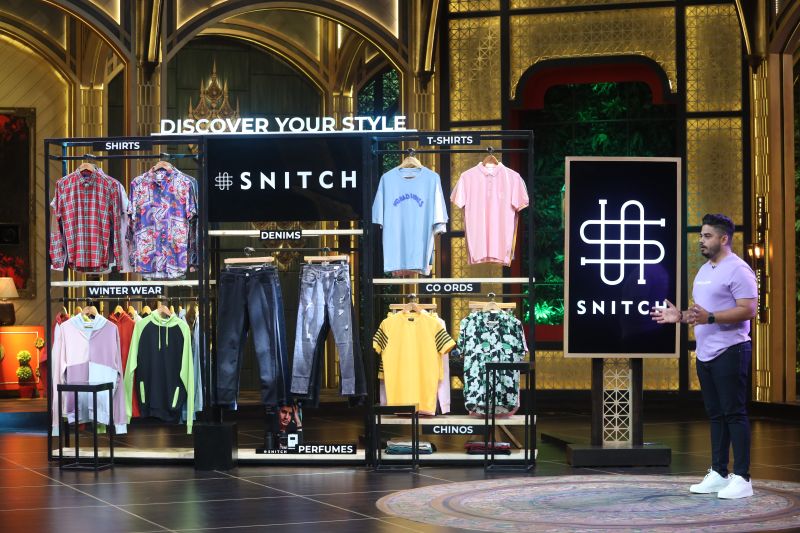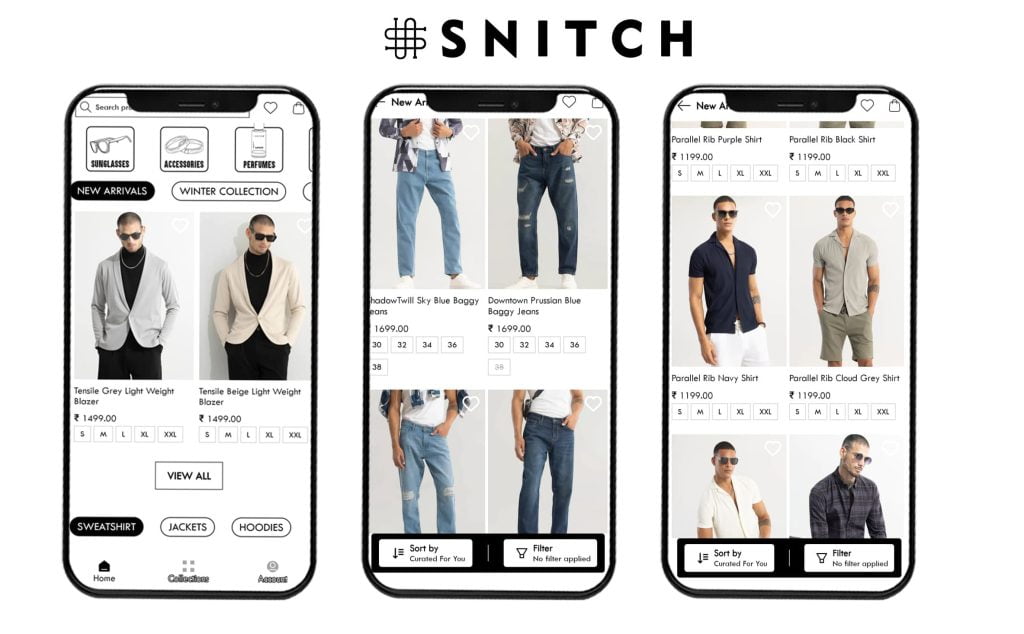

How Snitch's Direct-to-Consumer Model is Disrupting the Fashion Industry
- Blog Detail
- Mon Mar 2023
- No Comments
Snitch is a fashion startup founded in 2020 by Siddharth R Dungarwal, a 35-year-old commerce graduate from Bangalore. Siddharth, who had been involved in his family's jewelry business, began selling procured materials from factories in retail, before starting his own manufacturing business in 2012. However, he later identified a gap in the market for stylish and fashionable men's clothing and decided to launch Snitch.
Snitch is India's fastest-growing fast fashion brand for men, with a vision to become India's biggest fashion brand for men and to capture the global market. The brand's products, including shirts, t-shirts, denim, and more, are available on their own website and app, making shopping easy and convenient for customers. Snitch is one of the first brands to launch a cohort set for men, and all the clothes are made in India, positioning the company as a mass premium brand.
AIM OF THE STARTUP
The aim of Snitch, a fashion startup founded in 2020, is to provide stylish and fashionable men's clothing to customers in India and beyond. The company's vision is to become India's biggest fashion brand for men and to capture the global market.
Snitch aims to address the gap in the market for stylish and exciting men's clothing, providing options that are on-trend, colorful, and glamorous. The startup's website and app make shopping easy and convenient for customers, allowing them to access a range of products, including shirts, t-shirts, denim, and more, from the comfort of their homes.
Initially, Snitch operated as a B2B brand, selling manufactured clothes to retailers. However, the company shifted its focus to direct-to-consumer sales through their website and app due to the pandemic, allowing them to expand their market reach and offer their products to a broader audience.
With a commitment to quality, Snitch aims to provide top-notch clothing that can compete with big brands in the market. The startup has registered impressive growth, processing over 2000 orders daily, and with more than 50,000 daily active users and over 5 lakh app downloads. Snitch's aim is to continue expanding its reach and to establish itself as a leading fashion brand for men in India and beyond.
BUSINESS MODEL AND TARGET MARKET
The business model of Snitch, a fast-fashion startup, is a direct-to-consumer model. The company sells its products, including shirts, t-shirts, denim, and more, through its website and app, allowing customers to shop from the convenience of their homes. The startup's focus on a direct-to-consumer model has allowed them to expand their market reach and target a broad audience.
Snitch's target market is young men who are fashion-conscious and looking for stylish and trendy clothing options. The startup aims to provide men with clothing that is exciting, colorful, and fashionable, helping them express their individuality and sense of style. Snitch offers a range of products, including casual and formal wear, catering to a wide range of fashion needs.
With a mass-premium brand positioning, Snitch offers high-quality clothing at an affordable price point. The startup's goal is to capture the global market and become India's biggest fashion brand for men. Their direct-to-consumer model allows them to offer competitive prices while maintaining quality and meeting the demands of their target audience.
SALES AND REVENUE
The startup has achieved impressive sales and revenue growth. Last month's sales were ?9 crores, with revenue of ?6 crores generated from their own website. They also earned ?1 crore in revenue from the marketplace and ?2.3 crore from the B2B offline channel.
The COGS (Cost of Goods Sold) for Snitch is 42%, indicating that the company is spending a significant portion of its revenue on producing its products. However, the gross margin of 48% suggests that the company is making a healthy profit on its sales. Snitch's marketing costs are 28%, indicating that the company is investing in promoting its brand and products to its target audience.
Snitch's shipping cost and operating cost are 10% and 9%, respectively, which shows that the company is managing its logistics and operations efficiently. The EBITDA (Earnings Before Interest, Taxes, Depreciation, and Amortization) for Snitch is 5%, indicating that the company is generating a profit after accounting for all of its expenses.
Snitch is a fully bootstrapped company with a loan of ?4.5 crores, indicating that the company has managed to grow and generate revenue without external funding. In the financial year 21 to 22, Snitch's sales were ?44 crores, and they are projected to achieve sales of ?100 crores in the financial year 22 to 23.
JOURNEY IN SHARK TANKS INDIA
Snitch appeared on Shark Tank India seeking an investment of ?1.5 crores for 0.5% equity in the company, with a company valuation of 300 crores.
All the sharks on the show made an offer of ?1.5 crores for 1.5% equity in the company, with a company valuation of 100 crores. This means that the sharks valued Snitch at a lower valuation than what the owner had proposed.
After some negotiations, the owner of Snitch ultimately decided to accept the offer from all the sharks, which meant giving up 1.5% equity in the company in exchange for the ?1.5 crores investment.
This deal would give Snitch the much-needed capital to continue its growth and expansion plans. In addition, the sharks' investment and guidance could provide Snitch with valuable expertise and connections in the fast-fashion industry.
Overall, Snitch's appearance on Shark Tank India and subsequent investment deal with the sharks indicate that the company has gained recognition and credibility in the business world and is on a path towards further success.

Leave Your Comment
Save my name, email, and website in this browser for the next time I comment.
Ready To Get Started
At Professional Saathi, we offer a range of business consultancy services that help businesses improve their performance, achieve growth, and overcome challenges.

We Empower Businesses with Expert Consultancy Services
- Careers With Us
- Privacy & Policy
- Terms & Conditions
Services Locations
- Uttara Pradesh
- Maharashtra
- West bengal
Most Visited Links
- Customer Register
- Associates Login
- Business Associates Login
Copyright 2024 © Created By KTPG PROFESSIONAL SAATHI CORPORATE CONSULTANT PRIVATE LIMITED , All Rights Reserved.

- Business Ethics Cases
- Markkula Center for Applied Ethics
- Focus Areas
- Business Ethics
- Business Ethics Resources
Find ethics case studies on bribery, sourcing, intellectual property, downsizing, and other topics in business ethics, corporate governance, and ethical leadership. (For permission to reprint articles, submit requests to [email protected] .)
In this business ethics case study, Swedish multinational company IKEA faced accusations relating to child labor abuses in the rug industry in Pakistan which posed a serious challenge for the company and its supply chain management goals.
A dog may be humanity’s best friend. But that may not always be the case in the workplace.
A recent college graduate works in the finance and analytics department of a large publicly traded software company and discovers an alarming discrepancy in sales records, raising concerns about the company’s commitment to truthful reporting to investors.
What responsibility does an employee have when information they obtained in confidence from a coworker friend may be in conflict with the needs of the company or raises legal and ethical questions.
A manager at a prominent multinational company is ethically challenged by a thin line between opportunity for economic expansion in a deeply underserved community, awareness of child labor practices, and cultural relativism.
A volunteer providing service in the Dominican Republic discovered that the non-profit he had partnered with was exchanging his donor money on the black market, prompting him to navigate a series of complex decisions with significant ethical implications.
The CFO of a family business faces difficult decisions about how to proceed when the COVID-19 pandemic changes the business revenue models, and one family shareholder wants a full buyout.
An employee at an after-school learning institution must balance a decision to accept or decline an offered gift, while considering the cultural norms of the client, upholding the best interests of all stakeholders, and following the operational rules of his employer.
A senior vice president for a Fortune 500 savings and loan company is tasked with the crucial responsibility of representing the buyer in a multi-million dollar loan purchase deal and faces several ethical challenges from his counterpart representing the seller.
Extensive teaching note based on interviews with Theranos whistleblower Tyler Shultz. The teaching note can be used to explore issues around whistleblowing, leadership, the blocks to ethical behavior inside organizations, and board governance.
- More pages:
- Search Menu
- Advance articles
- Featured Content
- Author Guidelines
- Open Access
- About The British Journal of Criminology
- About the Centre for Crime and Justice Studies
- Editorial Board
- Advertising and Corporate Services
- Journals Career Network
- Self-Archiving Policy
- Dispatch Dates
- Terms and Conditions
- Journals on Oxford Academic
- Books on Oxford Academic

Article Contents
- What is Snitching?
- How Common Is Snitching?
- When Is It Okay to ‘Snitch?’
- The Current Study
- < Previous
Look Who’s Talking: The Snitching Paradox in a Representative Sample of Prisoners
- Article contents
- Figures & tables
- Supplementary Data
David C Pyrooz, Meghan M Mitchell, Richard K Moule, Scott H Decker, Look Who’s Talking: The Snitching Paradox in a Representative Sample of Prisoners, The British Journal of Criminology , Volume 61, Issue 4, July 2021, Pages 1145–1167, https://doi.org/10.1093/bjc/azaa103
- Permissions Icon Permissions
Snitching refers to conveying inside and potentially incriminating information about others to authorities. In contrast to prior criminological accounts of snitching, which rely on small and purposive samples, we used a probability sample of 802 male prisoners in Texas to study the status, prevalence, acceptability and correlates of snitching. We arrive at several key quantitative findings. First, snitches are positioned at the bottom of the inmate hierarchy. Second, snitching is a rare behaviour (7.6 per cent) and even rarer identity (1.8 per cent), consistent with a snitching paradox. Third, about three-fourths of respondents endorsed contingencies where snitching was permissible, primarily those involving personal ties, self-protection, or violence prevention. Finally, characteristics such as age, civic engagement, education, gang status, and arrest and imprisonment history were associated with either snitching identity, behaviour, or contingencies. Snitching is a persistent feature of social life, yet violates a sacred norm central to many criminological theories, necessitating continued inquiry into its content, enforcement and consequences.
Email alerts
Citing articles via.
- Recommend to your Library
Affiliations
- Online ISSN 1464-3529
- Print ISSN 0007-0955
- Copyright © 2024 Centre for Crime and Justice Studies (formerly ISTD)
- About Oxford Academic
- Publish journals with us
- University press partners
- What we publish
- New features
- Open access
- Institutional account management
- Rights and permissions
- Get help with access
- Accessibility
- Advertising
- Media enquiries
- Oxford University Press
- Oxford Languages
- University of Oxford
Oxford University Press is a department of the University of Oxford. It furthers the University's objective of excellence in research, scholarship, and education by publishing worldwide
- Copyright © 2024 Oxford University Press
- Cookie settings
- Cookie policy
- Privacy policy
- Legal notice
This Feature Is Available To Subscribers Only
Sign In or Create an Account
This PDF is available to Subscribers Only
For full access to this pdf, sign in to an existing account, or purchase an annual subscription.
Academia.edu no longer supports Internet Explorer.
To browse Academia.edu and the wider internet faster and more securely, please take a few seconds to upgrade your browser .
Enter the email address you signed up with and we'll email you a reset link.
- We're Hiring!
- Help Center

To Be or Not to Be a Snitch or a Whistleblower: Years of Silence at Penn State

Related Papers
IEEE Transactions on Professional Communication
Richard House
Dr. Chris Bonau Schmidt
State level mechanisms for soliciting, validating, and learning from whistleblower claims of fraud, theft, or misconduct against public colleges and universities are explored in four US states: California, Massachusetts, Michigan, and Ohio. Sequential public information requests were used to understand the methods that were used in each state, the types of claims that each state experienced, and to understand their processes for learning from such claims. The types of claims, breadth of scope that the claims span, and disposition of the claims is used to characterize each state's approach and compare and contrast results with other states in the sample. There was a wide variation in responses and approaches used in each state. Varying from no information solicited or maintained (Michigan) to full histories that include case level detail (Ohio), excellent multi-year case tracking and reporting (California) to the voluminous tracking of every property loss or damage in every institution (Massachusetts). An organic rubric is developed and used to compare and contrast the responses and service level provided by each of the states. Although anonymous whistleblower claims are essential to the governance and administration of higher education, state level mechanisms vary widely in their approaches to administering this process and ensuring better future outcomes. Establishing a standard based upon best practices would ensure that institutions are making the best use of all information available to them to improve their immunity from employee fraud and theft and misconduct.
Jennifer Kisamore
Although a large body of research has examined academic cheating, very little attention has been devoted to student reporting of academic misconduct. We argue academic integrity violations are similar to but different in some ways from whistle-blowing. Using data from 131 business students, we use hierarchical regression to show how demographic, personality, attitudinal and contextual factors combine to predict intention to report cheating. The adjusted R squared for the model is .45. Implications for future research and practice are discussed.
Katie Wright
Cultural Studies <=> Critical Methodologies
Charles R. Garoian
This article addresses the furtive environment, and willful ignorance at Penn State University that resulted in the alleged molestations of children by a football coach. An audacious criticality is advocated to lift the fog of spectacle surrounding the University’s football program, and to prevent any such depraved violations of the body from occurring again.
RAUSP Management Journal
Tatiana Iwai
Purpose This study aims to examine the effects of peer ethical behavior and individual differences in valuation of fairness vs loyalty on whistleblowing intentions in academic settings. This study also tests the underlying mechanism responsible for the effects of peer behavior on reporting intentions, namely, fear of reprisal. Design/methodology/approach A survey was conducted with 947 undergraduate students. The model was tested using ordinary least squares regression models followed by bootstrapped mediation analyses. Findings Results showed that the effects of peer ethical behavior on whistleblowing intentions are mediated by fear of retaliation. Moreover, the findings indicated that, for low-severity transgressions, there is an interactive effect between fear of retaliation and endorsement of fairness over loyalty on whistleblowing intentions. Research limitations/implications When the misconduct is seen as minor, a potential whistleblower may understand that the expected costs ...
Sarah Amira De La Garza
Wim Vandekerckhove , Tina Uys
book chapter from International Handbook of Whistleblowing Research
Ethical Theory and Moral Practice
James Stillwaggon
Part of the unsettling quality of the public revelations of sexual abuse over the past few years has been the fact that we are dealing with decades of missteps on the part of administrators, fellow teachers and the public at large, implicating more than just the immediate actors. In the past, when a teacher committed inappropriate sexual advances or acts upon a student, entire school communities often looked the other way and pretended there was no issue, or sent the teachers (along with letters of recommendation) to other teaching posts. Schools behaved like churches, each quietly serving as an arbiter of its own questionable moral code. Today, schools caught in the grip of scandal send apologetic emails, enlist lawyers and make promises to prevent future abuses. We feel a collective relief knowing that perpetrators, if not always punished, are at least no longer teaching at the scandalized school. Like so many administrators in decades past who simply dismissed teachers rather than addressed the problem openly, we comfort and content ourselves with the belief that the crime leaves the building with the predator, the monster, the sociopath.
RELATED PAPERS
Center for Public Policy and Democracy Studies (PODEM)
Ο ΝΟΥΣ Ο ΧΩΡΟΣ ΚΑΙΗ ΓΕΩΜΕΤΡΙΑ
George Mpantes
Ghidul gastronomic al Romaniei
Laurentiu Decu
Manal Shouman
George A Koulaouzides
eman mahmoud
Nutriologia Medica 589-822
Emiliano Morales Soto
Fundgeschichten - Archäologie in Nordrhein-Westfalen
Frank, Klaus
Alexandre Pardo
simone G M gilgenkrantz
Theriogenology
Yvette Carrillo
Nanotechnology
mehdi eskandari
Roberto Torres
Molecular Genetics & Genomic Medicine
taghreed ibrahim
Tendai Kurehwatira
ACM Journal of Experimental Algorithms
Jari M Kytöjoki
Marine and Petroleum Geology
Stuart Hardy
Bone Marrow Transplantation
Syed Oqail Ahmed
Information Sciences
Ari Y. Barrera-Animas
African Journal of Business Management
Coccia Mario
oSVALDO SIQUEIRA
Advanced NanoBiomed Research
Soodabeh Davaran
Adriana Ribeiro
OSTI OAI (U.S. Department of Energy Office of Scientific and Technical Information)
Shira Rosencwaig
Sergio Eduardo Visacovsky
Revista del Museo de Antropología
Sabrina Calandrón
RELATED TOPICS
- We're Hiring!
- Help Center
- Find new research papers in:
- Health Sciences
- Earth Sciences
- Cognitive Science
- Mathematics
- Computer Science
- Academia ©2024

Snitch took a D2C path in a marketplace world to attain 20X growth

Fashion & Apparel
COMPANY SIZE
Estd. 2019, Snitch is a homegrown men’s fast-fashion label, having humble roots in the textile industry in Bengaluru. With close to zero Slow Moving Inventory and new designs every single day, Snitch is making a limited number of limited editions per day which customers are gaga over. They have introduced and popularised men’s co-ordinated sets and become the pioneers in the men’s fashion segment. In a year Snitch has come from a hyperlocal market to a pan-India level. So, what makes this story special?
- Drop in demand for fashion, apparel and accessories due to the pandemic.
- Achieving exponential growth at the onset of the D2C boom.
- Mitigating the weak parts of the backend & leakages.
- Making the inventory sync real-time.
- Creating a demand, a need & appealing to fashion-first, brand enthusiast people.
- Diverse platform activation and 360-degree marketing strategies were put into place to attain 20X brand growth.
- Tightening the backend process to minimise the leakage and increase the net profit for the brand.
- Strategizing inventory exposure and optimising sell-through of existing inventory base, taking active steps to make inventory real-time.
While the COVID-19 ran amuck in the streets and people stopped in their tracks, scrambling to adjust to the new normal & restricting all their activity, a lot of established retail brands came online to deliver at home. During this time, Snitch, a fairly new player in the D2C game, went from a meagre 70 orders per day to over 1500 orders per day. How did this all happen?
During the pandemic, the online visibility of brands increased exponentially. With people spending more time on their screens, browsing through social media and OTT platforms became the norm. So, focusing on ads, making them appealing & hitting right on a) the intent & b) the proper target audience, GreenHonchos took the charge in making Snitch visible & appealing pan-India. Through hyperlocal campaigns, regional sales & precise, on-the-clock targeting, optimisation & hygiene of ads, GreenHonchos helped Snitch make an impact on the ads front. The ROI stood at 8X, with Snitch investing INR 750k+ & GreenHonchos delivering INR 6 Crs.
GreenHonchos helped Snitch in not only customer retention but also helped turn customers into brand loyalists & advocates. The end result was a mighty 50% returning customer base. Offering an enriching experience over the website, both on mobile and desktop, the GreenHonchos team geared up and made sure the daily new arrivals are up-to-date and communicated to the potential customers in real-time. Talking on the inventory front, Snitch’s model is based on producing more products in a limited quantity, making them limited editions of sorts. GreenHonchos spearheaded the inventory movement, even after very little stock coverage, we delivered consistent ROI to the brand. At any current point of time, we have maintained over 10,000+ active SKUs over at the Snitch website. GreenHonchos has since the past year, maintained an ROI of 8X to 10X, achieved 75 Mn+ annual visitors, given an INR 500 Mn+ annual revenue and 5,00,000+ orders per annum.
The growth journey of Snitch from a core retail B2B background to a D2C model, resulting in a 20X growth is just another example of how GreenHonchos has provided true D2C enablement to over 70+ retail brands. Join now to scale your brand to unprecedented heights!

It was a brief call of 15 mins with Navin and I was convinced that GreenHonchos would be the right partner for us. It’s been an incredible 10 months now and a huge shout-out to the team. They have been simply the best and ensured consistent growth. Looking forward to a long-lasting relationship.
Siddharth Dungarwal
(Founder – Snitch)
EXPLORE MORE IMPACTFUL STORIES

Snitch took a D2C path in a marketplace world to attain 20X growth.
- Growth Marketing
- Analytics & Insights
- Digital Branding

How House of Stori increased brand recognition by 50X in just 6 months
How House of Stori increased brand recognition by 50X in just 6 months.
- eCommerce Technology

Breakbounce achieved 5X website traffic growth in 4 months
Breakbounce achieved 5x website traffic growth in 4 months
- Marketplace
GET IN TOUCH
We have got a tailor made success blueprint for your business.
Let’s talk about it!
Knowledge is Power
Stay updated with the latest insights from the world of eCommerce.
I agree to sign up to the GH Pulse Newsletter
Want to take your eCommerce business to the next level? We help businesses make the most at every stage - from product conceptualization to achieving the maximum optimization & ROI on business operations.
Let’s Grow your business online

- NEWSLETTERS
- E-RETAIL CONSULTING
- ECOMMERCE TECHNOLOGY
- DIGITAL BRANDING
- MARKETPLACE MANAGEMENT
- ANALYTICS & INSIGHTS
QUICK LINKS
- Accelerator Programme
- Partnership Programme
- CSR Initiatives
- Case Studies
- Client Testimonials
- PRIVACY POLICY
- GH Commerce Cloud
- eRetail Consulting
- Marketplace Management
- Analytics & Insights
- International edition
- Australia edition
- Europe edition

Two views on snitching: from the bridge and the waterfront
It seems a spooky coincidence that last week's West End premiere of Budd Schulberg's On the Waterfront should open within a week of Arthur Miller's A View From the Bridge . "I'll be damned," said the 94-year-old Schulberg, when I told him about the timing. "I didn't realise that. I wouldn't mind seeing it".
Each work was forged at the time of the McCarthy-era House Un-American Activities Committee (HUAC) inquiries; each depicts communities of brutally exploited longshoremen; and both offer a morality tale about the rights and wrongs of informing. Schulberg's Waterfront says it's right. Miller's Bridge says it's wrong.
This is not an issue confined to America's anti-communist witch hunts. Few people would argue against ringing Crimewatch to turn in a rapist. Yet in between these extremes there's a moral minefield to pick yourself through. I like to think that if I had been present in that green room, I would have been proud to have confronted Carol Thatcher over her revolting use of golliwog . But I suspect I would have felt more sick than sanctimonious for turning her in.
It's a fair bet Miller would agree. And it's not too far-fetched to suppose Schulberg wouldn't. Miller did not submit names to HUAC. Schulberg did. Each of the authors' plays represents a staunch defence of that position - whether intentionally or not.
When Schulberg's Terry Malloy (Marlon Brando in the movie, Simon Merrells in the London stage version) testifies against the ironically named mobster Johnny Friendly (Lee J Cobb in the movie, Steven Berkoff in the play), it comes across as the noblest of acts. When Miller's Eddie informs - or, to use Miller's word, "rats" - on two illegal immigrants, it is portrayed as the most disgusting betrayal.
Schulberg maintains that the testimony scene in On the Waterfront was not written as an attempt to justify his and director Elia Kazan's decision to name names for HUAC. "I wouldn't have written it like that if I hadn't gone through the 40 days of actual waterfront hearings and taken extensive notes," he told me.
A sorer point is that it was Miller who was first to supply Kazan with a screenplay - called The Hook - about waterfront corruption. But Miller withdrew from the project because Harry Cohn, then president of Columbia Pictures, wanted the bad guys in Miller's script to be communist. Miller refused and Kazan turned to Schulberg.
"When I was working on On the Waterfront, I didn't know about Arthur Miller", Schulberg says. "It was just a coincidence. They were absolutely two separate, if overlapping projects."
But Miller didn't see it as a coincidence, and said as much. Did Schulberg resent the accusation? "Yes. I would say I did. Because it made me seem like I was trying to imitate Arthur and walk in his footsteps. I did not like it."
Schulberg never spoke to Miller about it. So the two authors never saw eye to eye. And maybe it's no bad thing that the view from Miller's Brooklyn Bridge does not quite take in Schulberg's New Jersey Waterfront.
- Arthur Miller
- Theatre blog
Comments (…)
Most viewed.
Snitching versus reporting: A qualitative analysis of barriers and facilitators to addressing safety concerns among high school students
- Published: 17 August 2022
- Volume 25 , pages 1177–1203, ( 2022 )
Cite this article

- Dorothy L. Espelage 1 ,
- Alberto Valido 1 ,
- Luz E. Robinson 1 ,
- Katherine M. Ingram 1 ,
- America El Sheikh 2 ,
- Ashley M. Woolweaver 1 ,
- Laura Koritz 4 ,
- Claudia G. Vincent 3 ,
- Brion Marquez 4 ,
- Hill M. Walker 3 ,
- Rita Svanks 3 ,
- Roslyn Reynoso Marmolejos 1 ,
- Courtney Medina 1 ,
- Zeke Meltsner 1 ,
- Kovida Yalamanchi 1 &
- Jordan Pennefather 5
3 Citations
Explore all metrics
Creating effective school-wide safety mechanisms depends on understanding students' previous experiences of reporting, however, students may also be apprehensive to report if it is considered “snitching.” Focus groups were conducted in the 2015–2016, 2016–2017 school years across four U.S. high schools ( N = 40). A phenomenological approach was used to answer research questions on how high school students define snitching, what they perceive as the barriers and consequences of snitching, and under what circumstances they perceive reporting as acceptable or effective. Findings suggest students differentiate between reporting and snitching based on the perceived severity of the issue, its proximity, and how effective adults' responses are likely to be. As U.S. schools move forward implementing tiplines and reporting apps to address school safety issues, students will need support on what to report, how to report it and who/where to report it to and school staff should also focus on addressing the cultural norms around reporting.
This is a preview of subscription content, log in via an institution to check access.
Access this article
Price includes VAT (Russian Federation)
Instant access to the full article PDF.
Rent this article via DeepDyve
Institutional subscriptions
Similar content being viewed by others

Assessing disparities in school safety: implications for promoting equality in current efforts to keep kids safe

Building Schools’ Readiness to Implement a Comprehensive Approach to School Safety

Effectiveness of a multifaceted implementation strategy for improving adherence to the guideline for prevention of mental ill-health among school personnel in Sweden: a cluster randomized trial
Alathari, L., Drysdale, D., Driscoll, S., Blair, A., Carlock. A., Cotkin, A., Johnston, B., Foley, C., Mauldin, D., McGarry, J., Nemet, J., Vineyard, N., & Bullwinkel, J. (2019). Protecting America’s schools: A U.S. Secret Service analysis of targeted school violence . United States Secret Service National Threat Assessment Center. Retrieved September 4, 2020, from https://www.secretservice.gov/data/protection/ntac/Protecting_Americas_Schools.pdf
Allnock, D., & Atkinson, R. (2019). ‘Snitches get stitches’: School-specific barriers to victim disclosure and peer reporting of sexual harm committed by young people in school contexts. Child Abuse & Neglect, 89 , 7–17. https://doi.org/10.1016/j.chiabu.2018.12.025
Article Google Scholar
Anderson, E. (1999). Code of the street: Decency, violence and the moral life of the inner city . W.W. Norton & Company.
Google Scholar
Bandura, A., Ross, D., & Ross, S. A. (1961). Transmission of aggression through the imitation of aggressive models. Journal of Abnormal and Social Psychology, 63 (3), 575–582. https://doi.org/10.1037/h0045925.
Bandura, A., & Walters, R. H. (1977). Social learning theory (Vol. 1). Prentice-Hall.
Berkowitz, A. D. (2004). An overview of the social norms approach. In L. Stewart & L. Lederman (Eds.), Changing the culture of college drinking: A socially situated prevention campaign (pp. 195–196). Hampton Press.
Berkowitz, R., Glickman, H., Benbenishty, R., Ben-Artzi, E., Raz, T., Lipshtadt, N., & Astor, R. A. (2015). Compensating, mediating, and moderating effects of school climate on academic achievement gaps in Israel. Teachers College Record, 117 (7), 1–34. https://doi.org/10.1177/016146811511700703
Boynton, M., & Boynton, C. (2005). The educator’s guide to preventing and solving discipline problems . Association for Supervision and Curriculum Development.
Breen, R. L. (2006). A practical guide to focus-group research. Journal of Geography in Higher Education, 30 (3), 463–475. https://doi.org/10.1080/03098260600927575
Choukas-Bradley, S., Giletta, M., Cohen, G. L., & Prinstein, M. J. (2015). Influence, peer status, and prosocial behavior: An experimental investigation of peer socialization of adolescents’ intentions to volunteer. Journal of Youth and Adolescence, 44 (12), 2197–2210. https://doi.org/10.1007/s10964-015-0373-2
Clampet-Lundquist, S., Carr, P., & Kefalas, M. (2015). The sliding scale of snitching: A qualitative examination of snitching in three Philadelphia communities. Sociological Forum, 30 (2), 265–285. https://doi.org/10.1111/socf.12162
Colaizzi, P. (1978). Psychological research as a phenomenologist views it. In R. S. Valle & M. King (Eds.), Existential phenomenological alternatives for psychology. Open University Press.
Creswell, J. W., & Poth, C. (2013). Five qualitative approaches to inquiry. In H. Salmon (Ed.), Qualitative inquiry & research design (pp. 76–82). Sage Publications, Inc.
Ditch the Label. (2016). The annual bullying survey 2016. Ditch the Label. https://www.ditchthelabel.org/wp-content/uploads/2016/04/Annual-Bullying-Survey-2016-Digital.pdf
Donahue-Keegan, D., Villegas-Reimers, E., & Cressey, J. M. (2019). Integrating social-emotional learning and culturally responsive teaching in teacher education preparation programs. Teacher Education Quarterly, 46 (4), 150–168.
Espelage, D. L., Robinson, L. E., Woolweaver, A., Valido, A., Davis, A., Hunt, K., Marmolejos, R. R., Medina, C. M., Meltsner, Z. H., Yalamanchi, K. S., Vincent, C. G., Marquez, B., Walker, H. M., Svanks, R., & Pennefather, J. (2021). Implementation of tiplines and reporting apps for school safety: A qualitative analysis of parent and school personnel perspectives. Journal of School Violence, 20 (3), 336–350. https://doi.org/10.1080/15388220.2021.1910518
Ferráns, S., & Selman, R. (2014). How students’ perceptions of school climate influence their choice to upstand, bystand or join perpetrators of bullying. Harvard Educational Review, 84 (2), 162–187. https://doi.org/10.17763/haer.84.2.h488313410l651mm
Furrer, C., & Skinner, E. (2003). Sense of relatedness as a factor in children’s academic engagement and performance. Journal of Educational Psychology, 95(1) , 148–162. https://doi.org/10.1037/0022-0663.95.1.148
Gaughan, E., Cerio, J. D., & Myers, R. A. (2001). Lethal violence in schools: A national study (Final Report). Alfred University. www.alfred.edu/teenviolence . Accessed 4 September 2020.
Kahn, J. (2007). The story of a snitch. Atlantic Monthly , 80–92. https://www.theatlantic.com/magazine/archive/2007/04/the-story-of-a-snitch/305703/ . Accessed 9 September 2020.
Knaack, P. (1984). Phenomenological research. Western Journal of Nursing Research, 6 (1), 107–114.
Larkin, R. W. (2009). The Columbine legacy: Rampage shootings as political acts. American Behavioral Scientist, 52 , 1309–1326.
Laskey, J. A. (1997). The gang snitch profile. Journal of Gang Research, 4 (3), 1–16.
Madfis, E. (2014). Averting school rampage: Student intervention amid persistent code of silence. Youth Violence and Juvenile Justice, 12 (3), 229–249. https://doi.org/10.1177/1541204013497768
Maxwell, J. A. (2013). Research proposals: Presenting and justifying a qualitative study. In V. Knight (Ed.), Qualitative research design: An interactive approach (pp. 214–253). Sage Publications.
Monroe, H. (2018). Adolescent friendships and relationships: When parents should step in . https://health.usnews.com/health-care/for-better/articles/2018-09-10/adolescent-friendships-and-relationships-when-parents-should-step-in . Accessed 4 September 2020.
Morris, E. W. (2010). “Snitches end up in ditches” and other cautionary tales. Journal of Contemporary Criminal Justice, 26 (3), 254–272. https://doi.org/10.1177/1043986210368640
Morrow, R., Rodriguez, A., & King, N. (2015). Colaizzi’s descriptive phenomenological method. The Psychologist, 28 (8), 643–644.
Moustakas, C. (1994). Epoche, phenomenological reduction, imaginative variation, and synthesis. In A. Virding (Ed.), Phenomenological research methods (pp. 84–102). Sage.
Chapter Google Scholar
Ninox. (2020). Ninox online database software . https://ninox.com/en . Accessed 4 September 2020.
Noftz, K. (2011). How caring adults can help youth with: Tattle, snitch, tell and report. Project Cornerstone . Retrieved September 4, 2020, from https://www.smore.com/vj3fy-friday-focus .
O’Brien, N., Munn-Giddings, C., & Moules, T. (2018). The repercussions of reporting bullying: Some experiences of students at an independent secondary school. Pastoral Care in Education, 36 (1), 29–43. https://doi.org/10.1080/02643944.2017.1422004
Perkins, J. M., Perkins, H. W., & Craig, D. W. (2020). Norms and attitudes about being an active bystander: Support for telling adults about seeing knives or guns at school among greater London youth. Journal of Youth and Adolescence, 49 (4), 849–868. https://doi.org/10.1007/s10964-019-01127-7
Planty, M., Banks, D., Cutbush, S., & Sherwood, J. (2018). School tipline toolkit: A blueprint for implementation and sustainability . RTI International.
Pollack, W. S., Modzeleski, W., & Rooney, G. (2008). Prior knowledge of potential school-based violence: Information students learn may prevent a targeted attack . US Department of Education.
Rosenfeld, R., Jacobs, B. A., & Wright, R. (2003). Snitching and the code of the street. British Journal of Criminology, 43 (2), 291–309. https://doi.org/10.1093/bjc/43.2.291
Slocum, L. A., Finn-Aage, E., & Taylor, T. (2017). The code of silence in schools: An assessment of a socio-ecological model of youth’s willingness to report school misbehavior. Youth & Society, 49 (2), 123–149. https://doi.org/10.1177/0044118X14528958
Stanton-Salazar, R. (1997). A social capital framework for understanding the socialization of racial minority children and youths. Harvard Educational Review, 67 (1), 1–40. https://doi.org/10.17763/haer.67.1.140676g74018u73k
Syvertsen, A. K., Flanagan, C. A., & Stout, M. D. (2009). Code of silence: Students’ perceptions of school climate and willingness to intervene in a peer’s dangerous plan. Journal of Educational Psychology, 101 (1), 219–232. https://doi.org/10.1037/a0013246
Thombs, D. L., & Osborn, C. J. (2019). Introduction to addictive behaviors . Guilford Publications.
Topalli, V. (2005). When being good is bad: An expansion of neutralization theory. Criminology, 43 (3), 797–835. https://doi.org/10.1111/j.0011-1348.2005.00024.x
Vincent, C. G., Walker, H., Espelage, D. L., Murray, C., Svanks, R., Pennefather, J., Valido, A., & Marquez, B. (2022). Initial field test of the SOARS (Student Ownership, Accountability, and Responsibility for School Safety) framework for high schools. National Association of Secondary School Principals Bulletin . https://doi.org/10.1177/01926365221102378
Vossekuil, B., Fein, R. A., Reddy, M., Borum, R., & Modzeleski, W. (2002). The final report and findings of the safe school initiative: Implications for the prevention of school attacks in the United States . U.S. Secret Service and U.S. Department of Education.
Weiss, K. (2013). “You just don’t report that kind of stuff”: Investigating teens’ ambivalence toward peer-perpetrated, unwanted sexual incidents. Violence and Victims, 28 (2), 288–302. https://doi.org/10.1891/0886-6708.11-061
Yates, J. (2006). ‘You just don’t grass’: Youth, crime and ‘grassing’ in a working-class community. Youth Justice, 6 (3), 195–210. https://doi.org/10.1177/1473225406069494
Download references
Author information
Authors and affiliations.
University of North Carolina Chapel Hill, Chapel Hill, USA
Dorothy L. Espelage, Alberto Valido, Luz E. Robinson, Katherine M. Ingram, Ashley M. Woolweaver, Roslyn Reynoso Marmolejos, Courtney Medina, Zeke Meltsner & Kovida Yalamanchi
University of Florida, Gainesville, USA
America El Sheikh
University of Oregon, Eugene, USA
Claudia G. Vincent, Hill M. Walker & Rita Svanks
Champaign, USA
Laura Koritz & Brion Marquez
Trifoia Inc., Eugene, USA
Jordan Pennefather
You can also search for this author in PubMed Google Scholar
Corresponding author
Correspondence to Dorothy L. Espelage .
Additional information
Publisher's note.
Springer Nature remains neutral with regard to jurisdictional claims in published maps and institutional affiliations.

Supplementary Information
Below is the link to the electronic supplementary material.
Supplementary file1 (DOCX 20 KB)
Rights and permissions.
Reprints and permissions
About this article
Espelage, D.L., Valido, A., Robinson, L.E. et al. Snitching versus reporting: A qualitative analysis of barriers and facilitators to addressing safety concerns among high school students. Soc Psychol Educ 25 , 1177–1203 (2022). https://doi.org/10.1007/s11218-022-09703-9
Download citation
Received : 14 September 2021
Accepted : 17 May 2022
Published : 17 August 2022
Issue Date : October 2022
DOI : https://doi.org/10.1007/s11218-022-09703-9
Share this article
Anyone you share the following link with will be able to read this content:
Sorry, a shareable link is not currently available for this article.
Provided by the Springer Nature SharedIt content-sharing initiative
- School safety
- School climate
- Trusted adults
- School discipline
- Find a journal
- Publish with us
- Track your research

Snitch: Crafting Tomorrow’s Style – A Men’s Apparel Revolution
by PanGrow | Jan 19, 2024

In the dynamic realm of fashion, where trends evolve and styles redefine, emerging brands often stand as beacons of innovation and distinctiveness. This case study delves into the narrative of Snitch, a burgeoning force in the world of men’s apparel, as it embarks on a transformative journey. From its inception to the present, Snitch has navigated the intricacies of the fashion industry, weaving a tale of creativity, resilience, and strategic vision.

Against the backdrop of a competitive market, Snitch has sought to carve its unique identity, challenging conventional norms and setting new standards for men’s fashion. This case study explores the brand’s evolution, highlighting key milestones, challenges faced, and the strategic decisions that have propelled Snitch into the spotlight.
Snitch, a dynamic brand in the market, has carved its niche through innovation and uniqueness. Known for its distinctive products/services, Snitch has a compelling presence in the industry. Founded in 2019, Snitch emerged as a fast-fashion label for men’s apparel. From its humble beginnings to noteworthy milestones, Snitch’s journey is a testament to resilience and adaptability.

They were the first to make matching outfits for men popular. In just one year, Snitch went from being known locally to being recognized all over India.
Market Research & Analysis

Understanding the Landscape
Snitch embarked on a thorough market analysis to gain a comprehensive understanding of the industry dynamics. This encompassed an exploration of market trends, size, and potential growth opportunities. Identifying key market drivers and challenges became instrumental in formulating effective strategies for brand transformation.
Consumer Behavior Study: Deciphering Preferences and Patterns
In recognizing the paramount role of consumer behavior, Snitch conducted an in-depth study to decipher the preferences and patterns guiding purchasing decisions. This involved analyzing consumer motivations, perceptions, and responses to market stimuli. Insights gleaned from this study played a pivotal role in tailoring products and communication strategies to resonate with the target audience.
Benchmarking in a Competitive Landscape
A meticulous examination of competitors’ strengths and weaknesses was undertaken to benchmark Snitch’s position in the market. Analyzing competitor strategies, product offerings, and market share provided crucial insights for strategic decision-making. This comparative assessment helped Snitch identify opportunities for differentiation and competitive advantage.
SWOT Analysis for Snitch: Strategic Self-Examination
Snitch engaged in a comprehensive SWOT analysis to assess its internal Strengths and Weaknesses, and external Opportunities and Threats. Evaluating internal capabilities and vulnerabilities, alongside external market conditions, facilitated the identification of strategic areas for improvement and innovation.
This analysis became a cornerstone in shaping the brand’s transformation strategy, leveraging strengths and mitigating weaknesses to capitalize on emerging opportunities and navigate potential
Strategies to Overcome Market Challenges
In the pursuit of brand transformation, Snitch meticulously outlined its goals, setting a clear and strategic direction for the journey ahead.

- The primary objective was to redefine the brand’s identity to align with evolving market dynamics and consumer expectations. Snitch aimed to not only navigate challenges but to emerge as a trailblazer in its industry.
- Snitch established specific, measurable, and achievable targets to ensure a focused and results-driven transformation. First and foremost, the brand set out to enhance market share by a defined percentage within a specified timeframe. Measurable metrics included sales growth, customer acquisition, and increased brand awareness through targeted marketing initiatives.
- Additionally, Snitch aimed for product/service innovation, setting specific benchmarks for the development and launch of new offerings. These targets were designed to be achievable within the constraints of the market landscape, ensuring a realistic approach to transformation.
- Consumer perception played a pivotal role in Snitch’s goals. The brand set quantifiable targets for improving customer satisfaction and loyalty, with measurable indicators such as Net Promoter Score (NPS) and customer feedback metrics.
By defining these goals with specificity, measurability, and achievability, Snitch aimed not only to transform its brand but to do so in a manner that could be objectively assessed, ensuring a successful and sustainable evolution in the competitive marketplace.
Marketing Strategies that Worked Well
Snitch implemented a savvy marketing strategy. Specializing in multichannel marketing solutions across email, web, and mobile apps, a marketing collaboration allowed Snitch to automate its marketing campaigns.

The brand utilized automated marketing communications through SMS and WhatsApp channels, particularly targeting customers who had abandoned their shopping carts. This approach resulted in impressive click-through rates (CTR) and open rates, contributing to enhanced customer engagement.
Under this marketing strategy, Snitch witnessed a notable 15-20% increase in its retention rate. The brand has been achieving consistent month-on-month revenue growth between 15-20%. Additionally, the introduction of Snitch’s app six months ago has proven impactful, accounting for over 35% of the brand’s total sales.
Looking forward, Snitch envisions its next phase of growth, intending to establish digital experience stores across India. These stores will serve as a platform for showcasing and making available the brand’s best-selling products, further expanding its reach and enhancing the overall customer experience.
Future Prospects
As Snitch continues its journey in the dynamic landscape of the fashion industry, the brand’s future prospects are poised for remarkable growth and innovation. With a solid foundation established through strategic initiatives, Snitch is well-positioned to capitalize on emerging opportunities and overcome challenges on the horizon.

Digital Experience Stores
Snitch is set to pioneer a new era with the introduction of digital experience stores across India. These stores will serve as immersive spaces where customers can engage with and explore the brand’s offerings, fostering a unique blend of online and offline experiences.
Product Diversification
The brand is gearing up for product diversification, aiming to expand its portfolio beyond its current offerings. This strategic move will cater to evolving consumer preferences, ensuring that Snitch remains at the forefront of fashion trends.
Technological Integration
Snitch recognizes the importance of staying technologically advanced. The brand plans to explore and integrate cutting-edge technologies to enhance the overall customer experience, from personalized shopping recommendations to a seamless online shopping journey.
Global Expansion
With a solid footing in the Indian market, Snitch has set its sights on global expansion. The brand aims to establish its presence in international markets, introducing its unique blend of fashion to a wider audience.
Sustainable Practices
Keeping in line with the growing emphasis on sustainability, Snitch is committed to adopting eco-friendly practices. The brand envisions incorporating sustainable materials and ethical manufacturing processes, aligning with the values of environmentally conscious consumers.
As Snitch continues to evolve and innovate, these strategic moves underscore the brand’s commitment to staying ahead of the curve. With a clear vision, adaptability, and a pulse on market trends, Snitch is poised to write the next chapter of its success story in the fashion industry.
In wrapping up Snitch’s story, this case study reveals a brand that’s not just keeping up with fashion trends but setting them. From smart marketing moves to cool digital stores and a commitment to being eco-friendly, Snitch is gearing up for a stylish future.
They’ve not only adapted to change but are leading the way in fashion innovation. With plans to go global, offer more cool stuff, and stay ahead in tech, Snitch is on a path to redefine men’s fashion. The brand’s journey is proof that blending tradition with new ideas can create something extraordinary. As the final strokes are painted, Snitch stands ready to inspire and lead the way into a new era of men’s apparel.
On the lookout for an impactful content marketing solution ? Your search ends now! Explore our offerings on the website to discover how we can elevate your business through effective WhatsApp marketing. Connect with us today!
Request a FREE Proposal Now!
By submitting this form, I agree that the Terms of Service and Privacy Policy .
Recent Posts
How red label’s ppc campaign skyrocketed sales – a case study.
Apr 24, 2024
Brooke bond Red Label, a largest-selling tea brand, embarked on a...
Unveiling the Secrets: How Airbnb Mastered the Art of Driving Organic Traffic Through Blogging
Apr 23, 2024
Driving organic traffic to websites is crucial for businesses to...
Cereal Success: How Email Pop-ups Catapulted Kellogg’s Marketing Win
Mar 20, 2024
Kellogg's, a household name in the breakfast cereal industry, has...
From Old to Bold: How Old Spice’s PPC Campaign Redefined Branding Success
Mar 19, 2024
Old Spice, a prominent brand in the world of men's grooming...
Related Blogs

Driving organic traffic to websites is crucial for businesses to increase...

Balancing Personalization and Privacy: Navigating Data Regulations in Digital Marketing
In today's data-driven world, the topic of data privacy has become a major...

Gmail and Yahoo’s New Sender Requirements: A Closer Look
In October 2023, Gmail and Yahoo dropped a bomb on the email industry by...

- Development
- Digital Marketing
Inside Snitch: Sales, Revenue and Tech-Driven Business Model

Snitch, the innovative company that appeared on Season 2, Episode 20 of Shark Tank India, is well-known to us all. Their impressive pitch won over the sharks, who offered them Rs 1.5 crore for a mere 1.5% equity, ultimately sealing the deal for Snitch.
In this article, we deep dive into the fascinating story of Snitch’s founders, explore their innovative business model, and discover how Snitch is leveraging cutting-edge technology to shape and elevate their brand.
About The Founder

Meet Siddharth R Dungarwal , the dynamic 35-year-old founder and CEO of Snitch, hailing from the bustling city of Bangalore. With a background in commerce and an undeniable passion for clothing since the tender age of 14, Siddharth considers himself a true hustler. After years of helping his father at his jewelry shop, he initially started his own business by selling procured materials from factories in retail. However, in 2012, Siddharth pivoted his focus to manufacturing, only to later spot a gap in the market and cleverly seize the opportunity through the establishment of Snitch.
Snitch Sales and Revenue
Here is a list of information about snitch sales and revenue that will help you understand the profit they have made up until 2022.
- Last month’s sales amounted to ₹9 crores.
- The company generated ₹6 crores from their own website, ₹1 crore from the marketplace, and ₹2.3 crore from the B2B offline channel.
- COGS accounted for 42% of the total sales, while the gross margin was 48%.
- The company’s marketing expenses were 28%, shipping costs were 10%, and operating expenses were 9% of the revenue, resulting in an EBITDA of 5%.
- The company is fully bootstrapped but has a loan of ₹4.5 crores.
- The company achieved sales of ₹44 crores in FY 21 to 22.
- The projected sales for FY 22 to 23 are ₹100 crores.
Business Model of Snitch
The Snitch business model works in three ways: first, through B2B sales; second, through D2C (direct-to-consumer) sales; and third, by offering reseller opportunities to users.
Revenue Sources
- D2C : Direct-to-customer is the primary source of their income. Even Snitch claims that it receives 95% of its orders from its own website, recording over 2,000 orders every day from across the country.
- B2B : At first, Snitch started as a B2B business in the marketplace. They primarily received bulk orders for printing t-shirts and other men’s clothing items.
- Reselling : In December 2022, Snitch partnered with Relove for people who want to share their old clothes that are in good condition, while others love to buy vintage fashion. This partnership represents the third source of income in Snitch’s business model.
How Snitch is using technology to shape his brand
Snitch is a forward-thinking entrepreneur who understands the power of technology in shaping his brand. By leveraging the latest tools and techniques, he has been able to create a unique and engaging digital presence that sets him apart from his competitors.
Social Media Marketing
One of the ways Snitch is using technology to shape his brand is through social media marketing . He understands that platforms like Instagram, Twitter, and TikTok provide an opportunity to connect with his target audience in a more direct and personal way. Snitch has developed a consistent social media strategy that includes creating visually stunning content, engaging with his followers, and leveraging the latest trends to stay relevant and fresh.
Augmented reality technology
Another way Snitch is using technology to shape his brand is through e-commerce. He has created an online store that not only showcases his products but also provides an immersive shopping experience. Using augmented reality technology , customers can see what the products will look like in their homes before making a purchase. Snitch has also implemented a sophisticated customer relationship management system that allows him to track customer behavior and preferences, tailoring his offerings to better meet their needs.
Artificial Intelligence & Machine Learning
Snitch has also embraced the power of artificial intelligence and machine learning in shaping his brand. By analyzing data on customer behavior and engagement, Snitch has been able to identify patterns and trends that inform his marketing strategy. He has also implemented chatbots and other AI-powered tools that provide personalized customer support and help streamline his business operations.
Overall, Snitch’s use of technology has enabled him to create a brand that is dynamic, engaging, and responsive to the needs of his customers. By staying ahead of the curve and leveraging the latest tools and techniques, Snitch is positioning himself as a leader in his industry and a force to be reckoned with in the digital world.
Hi, I am Tarun, and I have been working as a Digital Marketing Executive at Waffle Bytes since 2021. I am passionate about PPC and Search Engine Optimization (SEO), and I consider myself a philosopher of these field.
Lil Goodness at Shark Tank: Revenue, Counteroffer & Final Deal
Lenskart business model: revenue & cost structure, you may also like, building your team: strategies for assembling a winning..., telegram business model | how telegram make money, cardekho: sales, revenue & tech-driven business model, leave a comment cancel reply.
Save my name, email, and website in this browser for the next time I comment.
WhatsApp us

- Restaurant News
- Brand X Collab
- Food & Hospitality
- Paid Reports
- Unpaid Reports
Retail & Business
- Consumer Trends
- Retail Trends
- Retail Meaning
- What is Retail?
- Retail Employees Day
- Retail Business Ideas
- Retail Stores Guide
- Future Retail
- Retail Glossary
- Retail Acronyms
- Happy New Year 2024
Tech & E-Commerce
- Omni Channel
- Digital Trends
Fashion & Beauty
- Collaboration
- Sustanability
D2C & New Commerce
- Perspective
- Brand X Brand

- Subscription

How Snitch is Embedding Technology to Build a Successful Brand?

COVID-19 pandemic and the subsequent closure of physical stores have fundamentally changed the way businesses operate. With consumers across the globe turning to online shopping, an increasing number of brands are taking the direct-to-consumer (D2C) route to create a distinctive customer experience.
One such brand that started its just journey just 14 months back is Snitch. India's fastest growing fast-fashion brand for men, Snitch was founded by Siddharth R Dungerwal. This, ‘Made in India, For the World’ brand, is widely known for its fast-fashion approach that captures world-class trends. Siddharth R Dungerwal, Founder & CEO, Snitch while speaking at a webinar #EmpoweringD2C in collaboration with Shipway states, “Snitch was introduced to bridge the gap in the industry as there was no brand focusing on men’s fast fashion on a daily basis.”
“We started off with a litmus test – more into an offline channel – we distributed our stocks initially to a lot of retailers across India, which got tremendous response from the consumers. For Snitch, the first 100 customers were these retailers who then got 1,000 reviews from their customers. And then pandemic hit us – we were really stuck at the time and the best thing to do at that time was to go online. The first thing that came to my mind is maybe we should introduce the brand on Flipkart and Myntra and try and liquidate the stock. But then I realized a) we wouldn’t be making any money and b) the brand wouldn’t get any good recognition and that’s how with a team of four people I started on the Shopify platform and barely within 48 hours, Snitch started getting a good response,” he adds.
The focus of the brand is to produce a larger number of styles than quantities of a few styles. On average, the brand has been producing roughly 3,000 styles per year.
While building the brand, the toughest task for the brand was to win the trust of its consumers. The brand tried to win the trust of the consumers by resolving their queries even at odd hours.
“We used to upsell through chatbots. Those were the initial days and then we started getting a lot of automation done. I would say this is a mix of a lot of things and the other tough thing was that we were barely new in the space and we had no knowledge about D2C especially coming from a very different background but I built a very strong team – a mixture of experienced and freshers and this helped me scale the brand further,” he asserts.
Elaborating on how a strong team has been the backbone of the brand, he says, “It’s been about two-and-half months since we launched our app, and we have over 200k downloads currently. Our returning customer ratio is 44-48 percent which is phenomenal for a new brand like ours.”
Social Media Strategy
To start off, social media was the only platform where Snitch could market its products. Social media is the most easily accessible platform and most people spend most of their free time on social media these days. So that was the best place for Snitch to place itself.
“We have been successfully growing the Instagram family, as we started with 2,000 followers and now we have 100k + followers. We prefer to resolve all the queries on social media at the earliest possible,” he shares.
Betting Big on Sustainability
There is a common belief that fast fashion brands cannot be sustainable and environment-friendly. However, despite being a fast-fashion brand, Snitch is betting big on sustainability.
“We use organic cotton to produce our products. We will soon be introducing recycled polyester fabric. Almost 20 percent of our packaging is plastic-free and over the next 3-6 months we tend to make it 100 percent plastic-free.,” he asserts.
“We want to make a huge difference in the fast fashion segment through Snitch. Fast fashion and sustainability have always been poles apart, however, we are trying to get these two aligned in one single system,” he adds.
Marrying Technology With The Brand
No business can scale without technology and there is no doubt that technology is a core part of any D2C brand.
“We have done automation probably everywhere we could such as returns, exchange and the whole experience of the customers. Soon, we will be testing technologies like Artificial Intelligence and we are also planning to live-stream the videos,” he states.
“Livestreaming is the future. We are engaging with a lot of influencers and trying to build a mini-Instagram kind of feel into our website where a lot of consumers talk about our products. Where they can browse through the whole product journey or it could be towards the product quality or fashion tip or grooming ideas,” he further adds.
Future Plans
The brand that has already become a consumer’s favorite in the men’s fast-fashion category is soon planning to foray into the women’s fast-fashion category too.
“We have set certain targets for ourselves. Once we hit those targets, we will start with women’s apparel. It would be on the same lines as what we do presently and that’s what we do the best. We will stick to fast fashion and bring new fashion every single day,” he shares.
Apart from this, to expand the men’s category further, the brand will soon be launching the plus-size collection, accessories, and innerwear collection.
“Plus size is something that we are looking into seriously. Plus size is an untapped market. There are a few brands in the plus-size category but they are not into fast fashion,” he elaborates.
The brand is catering to its consumers through its own website/ app currently, and paving the way to launch it at marketplaces as well.
“Apart from this. we are also planning to open 15-20 digital stores across India and these stores would be more tech-driven. The stores will drive us towards branding, building trust, and they will provide the look-and-feel factor to the consumers,” says Dungerwal.
This fiscal, the brand, which is currently bootstrapped, is eyeing to clock Rs 50 crore in terms of net sales.

Copyright © 2009 - 2024 Franchise India Holdings Ltd

IMAGES
VIDEO
COMMENTS
The QSEN competencies provide an ideal framework to promote opportunities for analysis, reflective thought, and discussion. In the case of this scenario, the lead characters in a primary are setting perceive their performance as competent as they provide appropriate care to a newly-arrived psychotic patient. ... "Snitch, Snitch, Witch" Case ...
Show and Teach Empathy. Children may snitch because the want you to know that they know the rules. Acknowledge and praise the child for coming to you and knowing and following the rules. Validate their concerns and feelings. You might say, "Thank you for being concerned about your sister's safety about her jumping on the bed.".
Case studies in both the U.S. and the United Kingdom have reported that students often believe that snitching will make the situation worse by harming a person's reputation, being labeled a snitch or being socially excluded (Ditch the Label, 2016; Morris, 2010). This evidence suggests that most students understand the anti-snitching culture ...
Snitch, a direct-to-consumer fast-fashion startup, offers stylish and affordable clothing options for young men. With impressive sales and revenue growth, Snitch appeared on Shark Tank India and secured an investment deal with all the sharks. This case study examines Snitch's business model, target market, sales, and revenue growth, and Shark Tank India's investment.
The case of Michael Hash illustrates another way jailhouse snitch testimony can be used for impure ends: in Hash's case, law enforcement allegedly used a known jailhouse snitch as a de facto police agent in order to attain a conviction. Hash was just 15 when his 74-year-old mail carrier Thelma Scroggins was shot to death in 1996.
A Business Ethics Case Study. An employee at an after-school learning institution must balance a decision to accept or decline an offered gift, while considering the cultural norms of the client, upholding the best interests of all stakeholders, and following the operational rules of his employer.
These studies reveal a lot about the motivations for snitching (e.g. Topalli 2005) and managing the label of the snitch (e.g. Akerström 1989). It is common for participants in these studies to describe snitching as omnipresent yet not admit to snitching, producing a snitching paradox—'everybody is a snitch, except for the offenders in our ...
Snitch increases conversions and engagement with AI-Powered Smart Recommendations and Visual Search CASE STUDY Snitch is a fashion-forward brand for the modern Indian man. Snitch sells men's apparel across categories such as casual wear, formal wear, innerwear, and loungewear and launches at least four to five styles daily.
This study examines the impact of victim and defendant race on case screening, bail, and sentencing outcomes for 1,131 firearm offenses that occurred between 2015 and 2018 in St. Louis, MO.
Fears of being labelled a 'snitch', 'a snake' or 'a grass' pervaded the discussions, and were a clear barrier to help-seeking for youth participants: "I'm not a snitch because everyone who ever tells a teacher, they say snitches get stitches. That's what they say so I don't snitch" [Sch2a, male participant].
But the notion of the snitch does not always carry a negative connotation. Two classic works of art dealing with exploited longshoremen and released during the communist witch hunts of the McCarthy era House Committee on Un-American Activities depicted the role of snitching from opposing perspectives.
GreenHonchos has since the past year, maintained an ROI of 8X to 10X, achieved 75 Mn+ annual visitors, given an INR 500 Mn+ annual revenue and 5,00,000+ orders per annum. The growth journey of Snitch from a core retail B2B background to a D2C model, resulting in a 20X growth is just another example of how GreenHonchos has provided true D2C ...
Mon 16 Feb 2009 12.26 EST. It seems a spooky coincidence that last week's West End premiere of Budd Schulberg's On the Waterfront should open within a week of Arthur Miller's A View From the ...
rationalize their decisions to snitch or not to snitch3 (Akerstrom 1991; Friedrichs 1996; Heck ... difficult to isolate case studies from the social structure, community, and culture in which they exist (Vaughan 1983). ... following a discussion of the findings of my analysis. First, however, prior research on snitches ...
A case study was presented of a police-led organization, which included in-depth interviews with program leaders and mentors, participant observations, and a review of secondary sources over 2 years.
Sophie Washington: The Snitch Discussion Questions 1. As the book begins, Sophie shares she has a secret. What is the secret and what does she think will happen if she reveals it? 2. What secret is Sophie's little brother Cole hiding? 3. What is making sounds in Sophie's attic? 4. Why do Nathan Jones and the Gibson twins hang out with Lanie? 5.
The trouble is, even DAs and cops know that finding a citizen in a position to truly help is no simple feat. A fear of reprisal and a deep mistrust of law enforcement make people reluctant to come forward. To be sure, many people do testify, despite the dangers, yet most DAs are surprised when witnesses "stay north.".
Snitch was excellent programming. We need a dialogue on the issue of the use of snitches to manufacture evidence. The government has tremendous resources which can be overwhelming to the ...
but simply that it foreshadows certain consequences (Morris, 2010). Case studies in both the U.S. and the United Kingdom have reported that students often believe that snitching will make the situation worse by harming a person's reputation, being labeled a snitch or being socially excluded (Ditch the Label, 2016; Morris, 2010).
This case study delves into the narrative of Snitch, a burgeoning force in the world of men's apparel, as it embarks on a transformative journey. From its inception to the present, Snitch has navigated the intricacies of the fashion industry, weaving a tale of creativity, resilience, and strategic vision. Against the backdrop of a competitive ...
Inside Snitch: Sales, Revenue and Tech-Driven Business Model. written by Tarun Pal March 21, 2023. Snitch, the innovative company that appeared on Season 2, Episode 20 of Shark Tank India, is well-known to us all. Their impressive pitch won over the sharks, who offered them Rs 1.5 crore for a mere 1.5% equity, ultimately sealing the deal for ...
India's fastest growing fast-fashion brand for men, Snitch was founded by Siddharth R Dungerwal. This, 'Made in India, For the World' brand, is widely known for its fast-fashion approach that captures world-class trends. Siddharth R Dungerwal, Founder & CEO, Snitch while speaking at a webinar #EmpoweringD2C in collaboration with Shipway ...